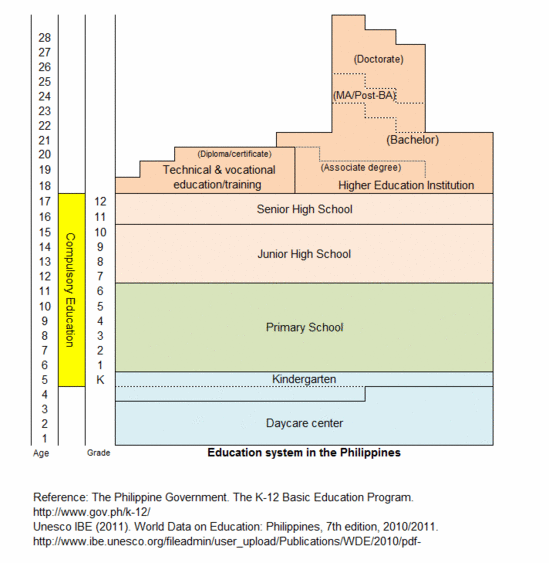| To better grasp the situation of ECEC around the world, it is essential to understand the circumstances in each country. In this section, we introduce basic information ranging from population size and educational investment in the country to educational systems, mainly focusing on the preschool phase. It is our humble hope that this information will be of some use to our readers who are interested in ECEC around the world. |
1. Capital: Manila
2. Population: 100 699 000 (2015)
3. Official/National Language(s): Filipino, English
4. Currency: Peso (PHP)
5. System of Education and Childcare
- Education system: Kindergarten (age 5), primary (ages 6-11), lower secondary (ages 12-15), upper secondary (ages 16-17), tertiary (age 18-)
- Regulating authority: Early Childhood Care and Development Council (ECCD Council; childcare), Department of Education (DepEd; primary and secondary education), Commission on Higher Education (CHED; higher education), Technical Education and Skills Development Authority (TESDA; technical and vocational education and training)
- Compulsory education: Ages 5-17
- In 2011, the K-12 basic education program started to extend the formerly 10-year compulsory education to 13 years by making the attendance in kindergarten mandatory and by adding two more years in secondary education as senior high school. The general education curriculum at universities is planned to be reduced in 2018 as the first cohort under the new system starts tertiary education.
- 3 year old: N/A
- 4 year old: N/A
- 5 year old: N/A
- 6 year old: N/A
- Pre-primary: N/A
- Primary, secondary, and post-secondary non-tertiary: N/A
- All levels of education combined: N/A
- Primary: N/A
- Pre-primary: N/A
- Primary: N/A
- PISA 2012: Not participated
- TIMSS 2011 (4th grade): Not participated

-
Reference
- 2. Population Division, United Nations. World Population Prospects: The 2012 Revision.
http://esa.un.org/unpd/wpp/unpp/panel_population.htm. - 5. The Philippine Government. The K-12 Basic Education Program. http://www.gov.ph/k-12/.
- CHED. "Impact on Higher Education."
http://www.ched.gov.ph/index.php/ched-k12-transition-program/the-k12-transition-in-higher-education/. - Unesco IBE (2011). World Data on Education: Philippines, 7th edition, 2010/2011.
http://www.ibe.unesco.org/fileadmin/user_upload/Publications/WDE/2010/pdf-versions/Philippines.pdf. - 6. OECD (2014). Education at a Glance 2014: OECD Indicators, OECD Publishing.
http://dx.doi.org/10.1787/eag-2014-en. Table C2.1 Enrolment rates in early childhood and primary education, by age (2005, 2012). http://dx.doi.org/10.1787/888933118333. - 7. OECD (2014). Education at a Glance 2014: OECD Indicators, OECD Publishing.
http://dx.doi.org/10.1787/eag-2014-en. Table B4.1. Total public expenditure on education (2011). http://dx.doi.org/10.1787/888933117573. - 8. OECD (2014). Education at a Glance 2014: OECD Indicators, OECD Publishing.
http://dx.doi.org/10.1787/eag-2014-en. Table D2.1. Average class size, by type of institution and level of education (2012). http://dx.doi.org/10.1787/888933119682. - 9. OECD (2014). Education at a Glance 2014: OECD Indicators, OECD Publishing.
http://dx.doi.org/10.1787/eag-2014-en. Table D2.2. Ratio of students to teaching staff in educational institutions (2012). http://dx.doi.org/10.1787/888933119682. - 10. OECD (2013). PISA 2012 RESULTS IN FOCUS. Snapshot of performance in mathematics, reading and science. http://www.oecd.org/pisa/keyfindings/pisa-2012-results-snapshot-volume-I-ENG.pdf.
- Martin, M.O., Mullis, I.V.S., Foy, P., & Arora, A. (2012).The TIMSS 2011 International Results in Mathematics. Chestnut Hill, MA: TIMSS & PIRLS International Study Center, Boston College. http://timssandpirls.bc.edu/timss2011/downloads/T11_IR_M_Chapter1.pdf, p.40.
- Martin, M.O., Mullis, I.V.S., Foy, P., & Stanco, G.M. (2012). The TIMSS 2011 International Results in Science. Chestnut Hill, MA: TIMSS & PIRLS International Study Center, Boston College. http://timss.bc.edu/timss2011/downloads/T11_IR_S_Chapter1.pdf, p.38.














